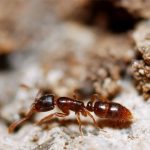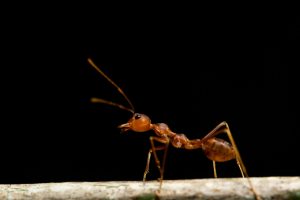
When it comes to pest control, ants can be one of the more difficult problems to overcome. Particularly if you are trying to do it yourself. The main reason for this is the volume of ants that can be present when an infestation occurs. Surprisingly, ants also have a very long life span.
In Australia there are over 4000 known species of ants. Only a handful of these (mostly introduced species) are considered pests.
Pest ants can be controlled with good food hygiene, sprays, dust and baits. Different species are attracted to different foods, sweets, meats, fats or oils. They will also often come inside seeking water in hot or dry weather. EPC – Enviro Pest Control uses the most appropriate method of control depending on the species of ant.
EPC – Enviro Pest Control has found the most common Ants in Melbourne to be;
- Black House Ant (Ochetellus glaber)
- Shiny and black
- 2.5 – 3mm long
- Are attracted to sweets
- Will scavenge in kitchens, garbage and also dog excrement, therefore potentially spreading diseases such as salmonella
- Singapore Ant (Monomorium destructor)
- Light brown with darker posterior abdomen
- 2-3mm long
- Head appears flattened and blocky
- Pharaoh’s Ant (Monomorium pharaonis)
- Yellow-brown in colour with black eyes
- 1.5-2mm long
- Prefers to feed on meat products and grease
- Argentine Ant (Linepithema humile)
- Approx. 1.6mm long
- Light to dark brown in colour
- Do not swarm
- Bite – do not sting
- Will follow food trails for long distances so nests are not easy to track
- Prefer sweet foods but will also eat live and dead insects, meats, cereals and damaged fruit
- Coastal Brown Ant (Pheidole megacephala)
- Approx. 1.5-2.5mm long
- Light yellowish brown
- Prefers to feed on meat products and grease
- Nests in dry areas, and build along pathways around the house including gardens and walls
- White footed House Ant (Technomyrmex albipes)
- Approx. 3 mm in length
- Dark brownish/black colour with pale legs
- Colonies can contain up to a million ants. They are complex and tend to spread into satellite colonies with nests in different locations
- Are attracted to sweet substances
- Carpenter or Sugar Ant (Camponotus spp)
- Are nocturnal
- Do not tend to travel in large numbers, so a trail may be difficult to spot
- Usually do not just set up one nest, but a whole series of ‘satellite’ nests
- Can do damage to wooden objects.
- Bull Ant (Mymecia)
- About 18 – 20mm long
- Tends to be red or black
- Very Aggressive
- Located mostly in bushy areas (they seldom enter buildings)
- Can inflict a very painful sting to humans and can sting repeatedly
- Feed on other insects and things such as honeydew from scale insects
Breeding and Life Cycle of Ants
The life cycle of an ant consists of four stages: egg, larva, pupa and adult. Eggs are small and ovoid in shape. Fertilised eggs become females (usually sterile workers), but at certain times also fertile females (which can potentially become queens). Unfertilised eggs become males.
The larva is a white grub with a narrow head. Adult workers feed the larvae and after sufficient feeding and several moults, the larva pupates. The pupa is similar in shape to the adult but is usually soft, white and inactive. In some species the pupa is protected by a silk cocoon. Once the adult emerges, its cuticle hardens and darkens. The development from egg to adult may take six weeks or longer, depending on the species, season and food availability.
Signs of Ant Infestation
Colony sizes vary; nests can range from a few dozen, to millions of individuals. Larger colonies consist mostly of sterile wingless females which form castes of ‘workers’. Workers may be specialised, for example into minor and major (or soldier) castes. These perform specific tasks, such as feeding and caring for the immature forms, and appear physically different. Nearly all ant colonies have fertile males called ‘drones’ and one or more fertile female called ‘queens’.
Spotting ants is usually not too difficult. This is due to the fact they put down pheromones as they walk and other ants will follow the same trail. This helps them find and collect food. While some ants create nests in the ground, others will make a nest inside walls or other dark places which can be harder to find. A colony can live a relatively long lifetime. Worker ants may live seven years and the queen may live as long as 15 years.
Getting Rid Of Ants

If you need to get rid of ants in Melbourne, you might think it is safe and effective to use products available at a supermarket. However, these will most likely not be effective and will not prevent the ants from coming back.
For EPC – Enviro Pest Control’s control service for ants, we firstly assess the situation and then recommend and implement a plan to eliminate the ants in accordance with their location, species, colony size etc.
Some common actions to help prevent ants include clearing away food, storing food in air tight containers or in the refrigerator and sweeping and mopping your floor regularly.
EPC Fun Facts about Ants
- An Ant can lift 20 times its own body weight. If a 6 year old was as strong as an ant they would be able to pick up a car!
- Ants don’t have lungs, they breathe through small holes found around their bodies.
- Most ants can survive about 24 hours underwater. Some ants can survive up to 14 days!
- The Saharan Silver Ant is the fastest ant in the world. It can speed at 855 millimetres per second—or 200 meters per second if it were the size of a human.
Why Choose EPC – Enviro Pest Control For Ant Control In Melbourne?
If you need to get rid of ants in Melbourne, you might think it is safe to use products available at a supermarket. However, these will most likely not be effective for large problems or will not prevent the ants from returning. You will also most likely be unaware of the chemicals they include and how dangerous they may be to you and your family’s health (including your pets).
When you call EPC- Enviro Pest Control, you can be sure you are dealing with experienced pest control specialists. No job is too large for our team and we have worked in many markets, hotels, factories and other commercial properties all across Melbourne. EPC – Enviro Pest Control can supply any commercial pest control service you need. Other reasons to choose us include:
- Reliable pest control service that will arrive on time
- Provide thorough assessments and effective plans for all your pest control needs
- EPC – Enviro Pest Control can create a tailored pest management plan for ants and other pests such as spiders, flies, termites and rodents
- EPC – Enviro Pest Control technicians are Trained Specialists and are very experienced at getting rid of ants
- EPC – Enviro Pest Control technicians are discreet, friendly and professionally presented
If you have an ant infestation or even just want to prevent one, call us at EPC – Enviro Pest Control today on (03) 9988 5066.
